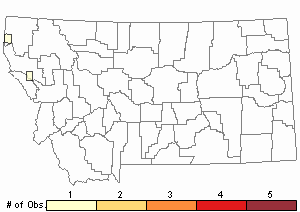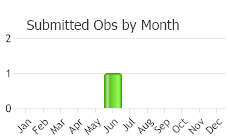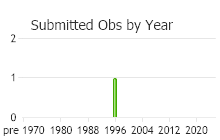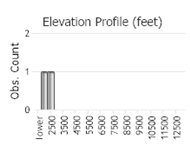View in other NatureServe Network Field Guides
NatureServe
Montana
Utah
Wyoming
Idaho
Wisconsin
British Columbia
South Carolina
Yukon
California
New York
Woolly Moss - Racomitrium lanuginosum
Other Names:
A Torncap Moss
General Description
Plants: Acrocarpous (Vitt 1988) Growing in clumps of erect shoots or patches, green with yellow or grey tones, or deep brown with black (FNA 2007), usually appearing hoary from the hyaline hair-points (Crum & Anderson et al. 1981). Stems occasionally over 15 cm, sometimes with rhizoids near the bottom (FNA 2007), typically with many tuft-like branches (Lawton 1971); lacking a central strand (FNA 2007).
Leaves: Closely spaced on the stem, upright and flat against the stem when dry, spreading slightly when moist, straight to curved and pointing in one direction, 3-5 mm in length, 0.6-0.9 mm in width, lance-shaped with linear tendencies; margins curved back and under or tightly rolled back for a little over half the leaf length, smooth below; apex slowly narrowing to a thin, long (FNA 2007) [laminal] hair-point (awn); hair-point to 2 mm in length (Lawton 1971), transparent, covered with papillae, decurrent along the margins about 1/4 to 1/3 of the leaf length, the decurrencies also transparent, raggedly toothed to smooth, spreading 40-90 degrees (FNA 2007); costa vanishing into the hair-point (Lawton 1971).
Leaf Cells: Costa in X-section quadrangular to kidney-shaped in profile, very rounded dorsally (FNA 2007); margins 1 cell-layer thick (Lawton 1971); upper laminal cells quadrangular and short; medial laminal cells elongate to linear, wavy and knobby; proximal laminal cells quadrangular, long, porose, and very knobby, with 1 or 2 rows of nonsinuose cells appearing as an orange band across the leaf attachment; alar cells not distinguished (FNA 2007).
Diagnostic Characteristics
No other acrocarpous moss is known to have papillose setae (FNA 2007).
The papillae of the laminal cells are identical in R. lanuginosum and Codriophorus species. However, Codriophorus species lack hair-points on their leaves (FNA 2007).
Range Comments
North American Range
AK to NL and NS (except SK, PE and NB), WA s to CA and e to MT, also NH and ME (FNA 2007). Known in Montana from Glacier, Lake, and Lincoln Counties (Elliott 2016).
Observations in Montana Natural Heritage Program Database
Number of Observations: 2
(Click on the following maps and charts to see full sized version)
Map Help and Descriptions
Relative Density

Recency



 (Observations spanning multiple months or years are excluded from time charts)
(Observations spanning multiple months or years are excluded from time charts)
Habitat
Usually dry and open habitats (although moisture levels can vary), usually on acidic (seldom calciferous) soil, stones, bluffs, talus slopes, tundra, peat hillocks, edges of bogs (FNA 2007), and barren, treeless mountaintops (Crum & Anderson et al. 1981). Elevation: 0-7550 feet (FNA 2007).
Reproductive Characteristics
Dioicous. Fruit uncommon. Seta 3-10 mm tall, spiraled counterclockwise when dry, papillose, brown, up to 3 setae per perichaetium (FNA 2007), often paired (Crum & Anderson et al. 1981). Capsule 1-1.7 mm in length, brown and lustrous, extending beyond the perichaetia; peristome teeth 2-lobed, divided nearly to the bottom into thread-like sections, each thickly covered with tiny, sharp papillae (FNA 2007).
Stewardship Responsibility
References
- Literature Cited AboveLegend:
 View Online Publication
View Online Publication Crum, H.A. and L.E. Anderson. 1981. Mosses of Eastern North America. 2 volumes. Columbia University Press, New York. 1328 pp.
Crum, H.A. and L.E. Anderson. 1981. Mosses of Eastern North America. 2 volumes. Columbia University Press, New York. 1328 pp. Elliott, J.C. and A.K. Pipp. 2018. A Checklist of Montana Mosses (1880-2018). Updated 3 January, 2020. Montana Natural Heritage Program, Helena, Montana. 73 pp.
Elliott, J.C. and A.K. Pipp. 2018. A Checklist of Montana Mosses (1880-2018). Updated 3 January, 2020. Montana Natural Heritage Program, Helena, Montana. 73 pp. Flora of North America Editorial Committee, eds. 2007. Flora of North America North of Mexico. Volume 27. Bryophytes: Mosses, Part 1. Oxford University Press, Inc., NY. xxi + 713 pp.
Flora of North America Editorial Committee, eds. 2007. Flora of North America North of Mexico. Volume 27. Bryophytes: Mosses, Part 1. Oxford University Press, Inc., NY. xxi + 713 pp. Lawton, E. 1971. Moss Flora of the Pacific Northwest. Hattori Botanical Laboratory. Japan: Yamabuki-cho, Shinjuku-ku, Tokyo. 362 pages plus appendices.
Lawton, E. 1971. Moss Flora of the Pacific Northwest. Hattori Botanical Laboratory. Japan: Yamabuki-cho, Shinjuku-ku, Tokyo. 362 pages plus appendices. Vitt, D. J. Marsh, and R. Bovey. 1988. Mosses, Lichens & Ferns of Northwest North America. Seattle, WA: University of Washington Press. 296 p.
Vitt, D. J. Marsh, and R. Bovey. 1988. Mosses, Lichens & Ferns of Northwest North America. Seattle, WA: University of Washington Press. 296 p.
- Additional ReferencesLegend:
 View Online Publication
View Online Publication
Do you know of a citation we're missing? Elliot, J. C. 1993. Second checklist of Montana mosses. Unpublished report. U.S. Forest Service, Region 1. Missoula, MT. 45 pp.
Elliot, J. C. 1993. Second checklist of Montana mosses. Unpublished report. U.S. Forest Service, Region 1. Missoula, MT. 45 pp. Lawton, E. 1971. Keys for the Identification of the Mosses on the Pacific Northwest. Reprinted from 'Moss Flora of the Pacific Northwest'. Published as Supplement No. 2 of the Journal of the Hattori Botanical Laboratory. Nichinan, Miyazaki, Japan. 66 pp.
Lawton, E. 1971. Keys for the Identification of the Mosses on the Pacific Northwest. Reprinted from 'Moss Flora of the Pacific Northwest'. Published as Supplement No. 2 of the Journal of the Hattori Botanical Laboratory. Nichinan, Miyazaki, Japan. 66 pp. Malcolm, B., N. Malcolm, J. Shevock, and D. Norris. 2009. California Mosses. Nelson, New Zealand: Micro-Optics Press. 430 pp.
Malcolm, B., N. Malcolm, J. Shevock, and D. Norris. 2009. California Mosses. Nelson, New Zealand: Micro-Optics Press. 430 pp. Smith, A.J.E. 1980. The Moss Flora of Britain and Ireland. Cambridge University Press, Cambridge. 705 pp.
Smith, A.J.E. 1980. The Moss Flora of Britain and Ireland. Cambridge University Press, Cambridge. 705 pp.
- Web Search Engines for Articles on "Woolly Moss"





